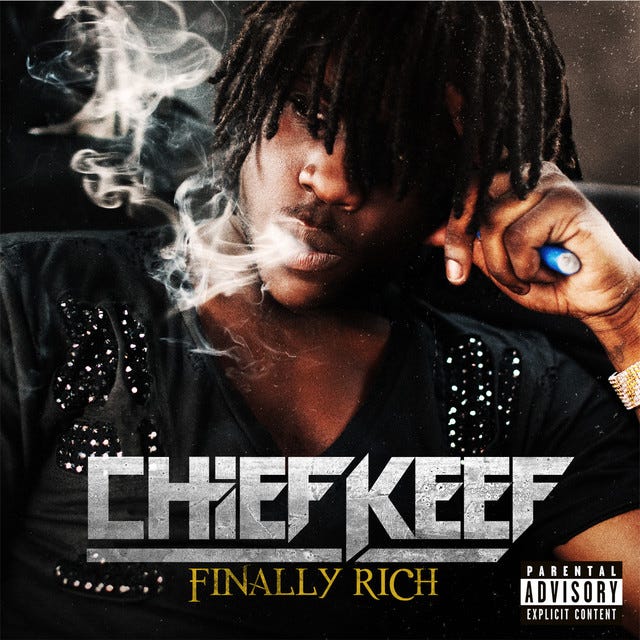Genre of the Day - Drill
Album of the Day - Finally Rich by Chief Keef (2012)
Yesterday’s spooky trip into a distorted, devilish subgenre of Brazilian funk was hopefully a crowd-pleaser for its relevance to Halloween. Drill may not be as explicitly a fright. Nonetheless, it possesses some of the same dark and intense qualities that characterize beat bruxaria. Just as with Brazilian funk, drill has taken on new identities as it has become a rap mainstay across cities and countries, and its family tree boasts a bunch of little mini-drills. This year has seen the rise of sexy drill, a flirtatious or unhinged phenomenon out of New York depending on how you slice it. Maybe by next Halloween we’ll have spooky drill.
Never mind the future of drill, though its reach still manages to be growing; just look at the ascendant number of drill releases from its early years to now. Drill emerged in Chicago in the early 2010s, the city that has epitomized the interlinkage between street culture and rap in the last decade or so alongside Atlanta. The connection goes deeper; drill evolved from Atlanta’s trap, challenging its sonic hegemony with its own rhythmic uniqueness and bulldozing bass heaviness. Drill makes use of more intense bass and energized rhythms possibly owed to some footwork and juke influences oozing in, a facet of Chicago’s unique dance styles. Drill is deeply tied to its location, making its ascendance a win for the city that’s reminiscent of the storylines of dirty south or Milwaukee’s lowend. Thematically, it’s not just centered on a neighborhood but synonymous with a single block, Chicago’s Parkway Garden Homes more commonly known as O-Block. The notorious center of the city’s gang activity and frequent shootings, many of drill’s key auteurs spun their real-life tales of rivalries and contention from the block into maximalist rap gold as the genre became a phenomenon.
Drill was at the forefront of an evolution in rap’s consumption as the download, SoundCloud, and YouTube eras began to give regional rap records new degrees of transmissibility and exposure. Artists like Chief Keef became recognizable successes rapidly, retaining the raw, aggressive essence of drill without having to capitulate to pop trends. Drill’s fluidity and energy captured a generation of young rap producers and listernes, becoming a vast ecosystem of regional subgenres. I covered UK Drill all the way back when I believe this blog had one subscriber; it makes use of sleek-yet-gritty moodiness, sharpening drill’s corners. The center of drill has arguably shifted east, as Jersey club-infused drill and New York drill’s unmistakable sliding sub bass rhythms reinvigorated drill in its second decade.
Chief Keef released one of the most acclaimed rap albums of 2024, yet his classic Finally Rich at the dawn of drill holds up as a definitional, time-transcending moment. Anchored by ubiquitous classics like “Love Sosa,” its title a reference to the Scarface gangster, “I Don’t Like” and the concerning “I Hate Bein’ Sober,” it’s an electrifying marriage of Chief Keef’s melodic and charismatic deftness with urgent, undeniable beats. The vaguely gothic chime touches of “I Don’t Like” combined with the militaristic simplicity and commandingess of the chorus that continues to grab you a decade later. “3Hunna,” a reference to his particular clique within a gang, is one of the most true-to-drill statements, triumphants horns and bells swinging with wild abandon. Even when he faces forward more directly towards the listener in a more poppy-leaning Mike Will Made It beat as on “No Tomorrow,” his dedication to his artistry and making it for his family comes through as he proclaims he goes so hard for his daughter. The euphoria of “Kay Kay” and “Ballin’” with its sanguine, flashy synths presage rap trends like plugg years ahead. And with each stream, you can indulge in the idea that Chief Keef really is laughing to the bank, though his triumph on this album is really no laughing matter.





What's the difference between drill and trap?
For spooky/sexy check out fairy trap